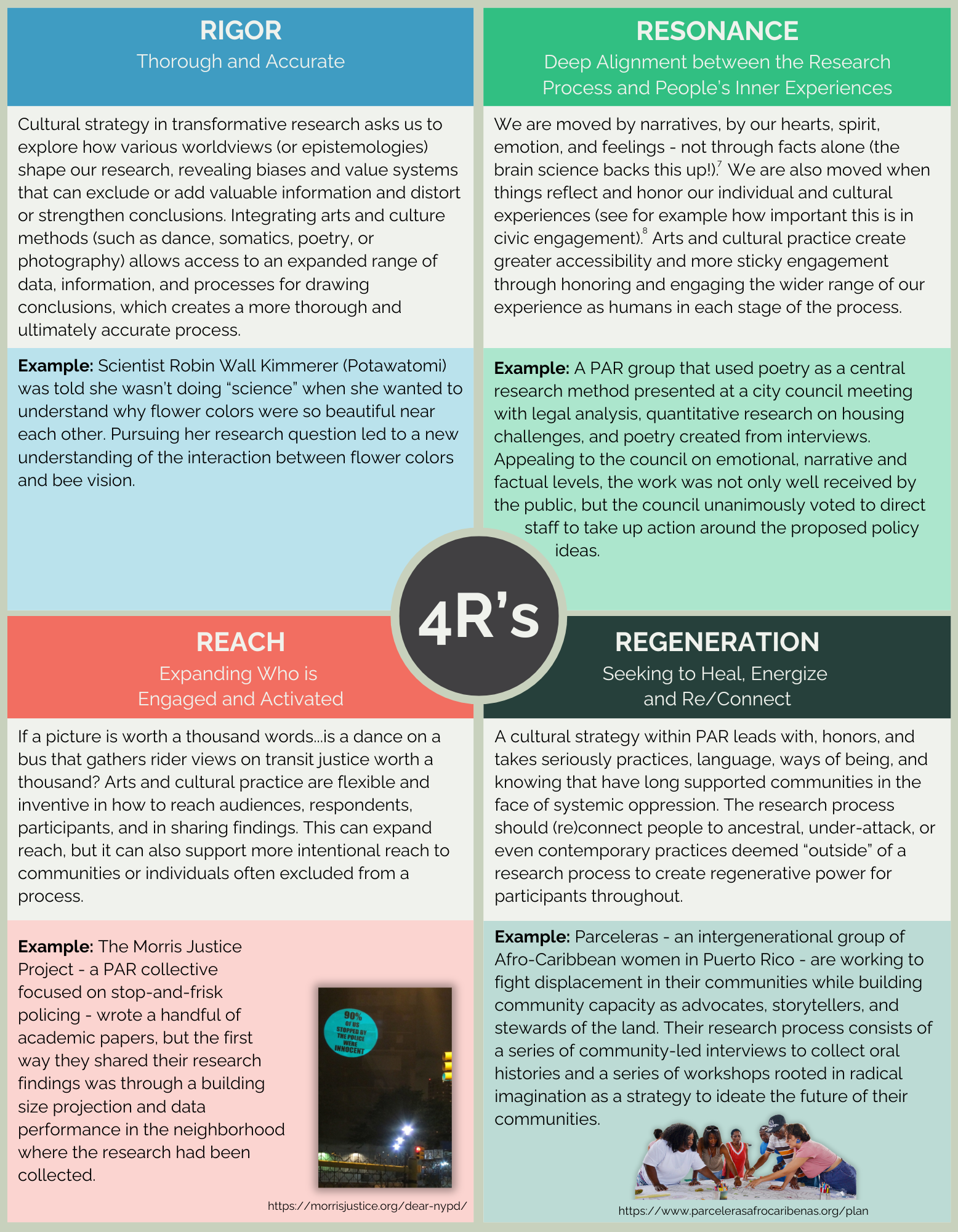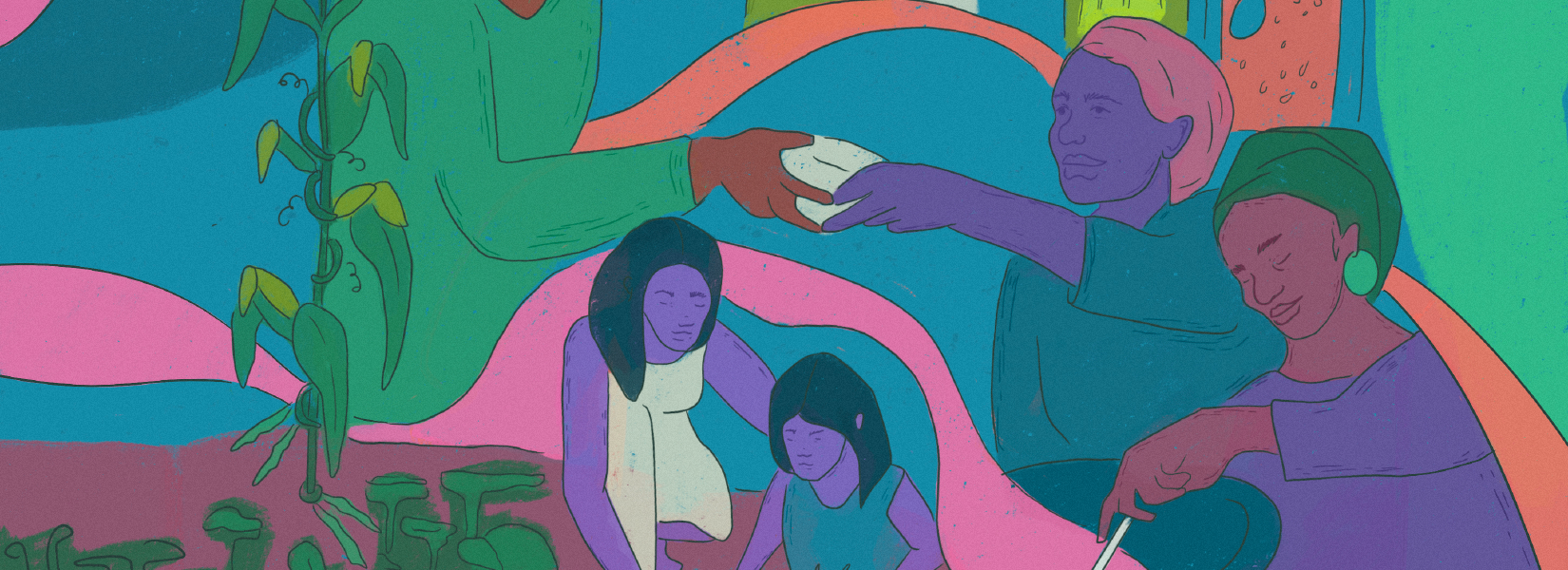Centering Cultural Knowledge: Methods of Surviving and Thriving
Centering cultural knowledge means turning to questions about what is helping a community survive and thrive. These methods of surviving and thriving get passed down and can be replicated and adapted to support healing generational harm and power building. Centering community knowledge may also require a critical look at types of community and cultural knowledge that create othering and oppression within a community and how to shift away from those. The following questions have helped us facilitate community analysis that recenters and cultivates your community’s knowledge:
- Today and in the past, how have Indigenous peoples and local communities honored cultural systems of knowledge that support healing, belonging, and justice?
- How do Indigenous peoples and local communities develop knowledge systems that survive and thrive within this current historical context?
- What are the frameworks to critically analyze methods of survival toward the contributions of the people’s freedom?
- What knowledge would help the community expand methods of surviving and thriving that are serving community wellness?
- How do communities analyze the strengths of communities as opposed to their problems?
- How do communities honor and revive ancestral traditions and cultural ways of knowing?
- How do community members center their mother’s mother’s consciousness? What knowledge shouldn’t be shared outside of your community for danger of it being used to criminalize survival or extract resources and value?
These analyses foster remembrance of local and Indigenous sacred science, drawing from histories of knowledge systems of civilization development, cosmology, and ancestors’ traditions that are integral to local community healing and transformation.
Indigenous peoples and local communities have a long history of cultivating knowledge to innovate and sustain methods for surviving and thriving. There are examples from ancestors, such as Hawaiian performances conveying cartographic knowledge, and Navajo verbal maps and sand paintings.6 Enslaved West Africans brought to Brazil were banned from practicing their culture and martial arts but invented ways to embed knowledge of their cultural identity and self-defense in play and dance through capoeira. These forms of knowledge and methods of surviving and thriving, often but not exclusively held in what might today be considered “artistic” practices, were often banned or undermined by dominant institutions because of the ways the knowledge created openings for self-determination. The Black/American Maroons in the Americas and Caribbean (from Florida, Cuba, and Mexico) reclaimed research as a system of community inquiry to develop their community infrastructure of sustainability.
Connecting Cultural Knowledge to Cultural Strategy in Research
As organizers, we are rooted in deconstructing oppressive systems through action, power analysis, and campaigns. Depending on how you approach organizing, it can feel like there is precious little time to add research as well as cultural knowledge or artistic practices into something so urgent and concrete. People often ask, do we have capacity to work with an artist? What if they don’t follow the talking points or timeline exactly? How does this align with our organization’s mission?
Our experience has been that integrating cultural strategy into transformative research makes space for visioning, world building, and radical imagination. A shared, transformative vision deepens connectedness, motivation, and commitment; in other words, the resonance of our work. Resonance happens when two or more things align to create a greater reaction or impact than they have individually. This element of resonance leads to work that is more deeply rooted and engages people in ways where they keep coming back. Resonance can lead to belonging within our movements. As the Movement Generation’s Just Transition principle goes, “If it is not soulful, it is not strategic.”
Where does your knowledge come from? How was it transmitted?
How do you decide what knowledge matters and what doesn’t?
Transformative research is meant to inform, catalyze, and support action for collective liberation. The type of data or information—in other words, the things we notice or not as part of research—or noticings that are allowed to be part of a research process informs the type of action that comes from that. A cultural strategy within transformative research is a political decision to disrupt dominant knowledge forms by intentionally widening the field of “data,” the practices of analysis, and how they are shared or activated in the world. It is not a rejection of a systematic process of generating knowledge but an expansion that is complicated and nuanced, with attention to not only whose knowledge is valued but what knowledge and how that knowledge is generated.
Cultural strategy in transformative research is the intentional decision within your research process to acknowledge, validate, notice, and integrate knowledge, practices, and worldviews that have led to survival, continuity, and thriving in the context of racial capitalism and white supremacy. Integrating the arts, cultural practice, and vernacular ways of knowing and being—that is, the aesthetic, the emotional, the embodied, intuition, traditional knowledge, noticing, listening, and ritual, among others—is a strategic decision to shift power in a research process. It brings in practices (such as those outlined in the previous section) that have been deemed by dominant cultures as nonauthoritative and nonobjective and, therefore, not of value in shaping systems. It can, and should, also create greater transparency in the relationship between the “observer” and the “observed” by shifting who holds actionable “expertise."
How Cultural Strategy Strengthens Transformative Research–The Four Rs
Hopefully, by this point you’ve bought into the idea of cultural strategy, or better yet, you’re a longtime practitioner. But how does cultural strategy strengthen research that aims to advance organizing goals? The four Rs framework can help orient your team to the value and possibility of this integration. It can also be a helpful way to assess the impact of your strategies.7 8

Where to Start?
What's the difference between doing a mural or open mic on its own versus doing a mural or open mic as part of a transformative research process?
Oftentimes when organizers and researchers integrate art or culture, it is to convey a message or idea through an outcome like a mural or poem. The integration of transformative research into an arts or cultural process starts by recognizing that there is knowledge being generated through arts and culture. For example, making two hundred dumplings could just be that, or it could allow for oral history gathering while making them. Often, you don’t have to do anything dramatically different. Rather it is a shift in thinking about how to systematically gather knowledge throughout the arts and cultural process without turning it into an extractive or tokenizing experience. Shifting processes in this way can amplify the value and significance of existing practices.
As you begin to work with artists, cultural strategists, culture bearers, or creatives, here are some questions that can help you get started without adding too much extra work to your plate:
- What do you and your organization consider to be actionable knowledge or “data”? Where does this sense of validity come from? Is it useful or can it be expanded?
- What practices and knowledge forms are already present and vital to you and your community? Is there an existing arts or cultural practice in your organizing work that can contribute to knowledge generation and research?
- What barriers exist internally and externally to activating this type of work? What resources or partnerships could support this activation? What would you have to do to bridge cultural knowledge with the demands of dominant practices in policy-making?
A Shifting Role for Artists
It is worth saying directly to the artists: working within a transformative research process means you will also likely have to shift your practice. You will be part of a group, opening up questions about authorship and ownership and the legacy of who can “claim” the work. The process will also ask you to be intentional about the connection to action, something that artists can at times resist out of an aversion to being overly direct or instrumental. On the other hand, to not “erase” yourself as an artist, you must be able to say what your nonnegotiables are (what won’t you change in how you do your work?) and be acknowledged for your specific experience and expertise.
It is important to also reflect on your relationship to research—in other words, do you create from knowledge created by others or do you facilitate a process through your practice? Skills you can expect to use in a transformative research process include creative, artistic, and rooted forms of facilitation, documentation, reflection, and analysis. For example, you may be a skilled poet, but you might also have to build skills around facilitating writing for others, group analysis of a poem, or developing creative opportunities to bridge policy or research materials.
- 6Margaret Pearce and Renee Louis, “Mapping Indigenous Depth of Place,” American Indian Culture and Research Journal 32, no. 3 (2008): 107–26, https://doi.org/10.17953/aicr.32.3.n7g22w816486567j.
- 7Rachel D. Godsil, “Mind Sciences and Creating New Narratives,” Othering & Belonging Institute, March 23, 2018, https://belonging.berkeley.edu/mind-sciences-and-creating-new-narratives.
- 8Lisa García Bedolla and Melissa R. Michelson, Mobilizing Inclusion: Transforming the Electorate through Get-Out-the-Vote Campaigns (New Haven: Yale University Press, 2012).





